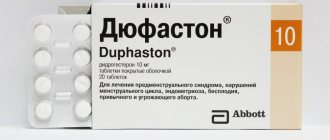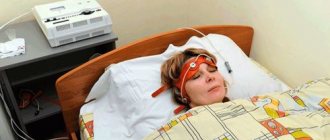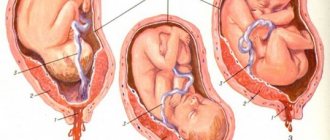Duphaston when planning pregnancy
The reproductive system is one of the most complex in the body. It is strongly influenced by external factors: life in a metropolis, poor nutrition, daily stress.
These moments cause hormonal disruptions and negatively affect a person’s sexual function. Hormonal regulation ensures the interaction of the organs of the female reproductive system, and disturbances in its functioning complicate the process of conception. Hormone deficiency (in this case, progesterone) is compensated by the use of modern medications.
Before ovulation or after?
When planning a pregnancy, Duphaston and ovulation are inextricably linked. It is recommended to take the drug after its implementation: the release of the egg from the ovary. This regimen is followed because in the second phase of the cycle, progesterone is produced naturally. Taking Duphaston in this case will only support and regulate the correct functioning of hormonal levels.
In some cases, the medication is recommended to be used from the first days of the cycle. This regimen is chosen for women who require treatment for hormonal diseases: endometriosis, hyperplasia, dysmenorrhea, amenorrhea and others. To choose the appropriate regimen for using the medication, you should contact a gynecologist and undergo diagnostics.
Patients taking the drug are interested in the question of whether Duphaston suppresses ovulation. This is especially important for those representatives of the fairer sex who are planning a pregnancy. If you look at the annotation, you won’t be able to find out anything about the contraceptive effect of Duphaston. The manufacturer does not say that the medicine blocks the release of an egg from the ovary.
However, delving into the principle of operation of the female body, one may doubt. After the natural release of the egg from the follicle, a corpus luteum forms at the site of the ruptured sac. It produces progesterone, and the adrenal glands help it with this. This process blocks the cyclic change of hormonal levels and prevents ovulation for all subsequent months of pregnancy. In this way, the body protects itself from re-fertilization.
But does this mean that the drug blocks ovulation if taken before the prescribed time? No you can not.
Obstetrician-gynecologist, doctor of the highest category, candidate of medical sciences, director of the Repromed family clinic Elena Kanaeva comments:
– Duphaston does not block ovulation; when taken from the 11th or 14th day of the cycle, ovulation will in any case occur in the mode in which the menstrual cycle operates.
However, Duphaston does not act as a stimulant. The medicine does not promote follicle growth and opening, that is, it does not stimulate ovulation. Although it does not suppress it.
Characteristics of the drug
Duphaston is a potent drug whose active substance is dydrogesterone. Dydrogesterone is a synthetic analogue of progesterone, effective when taken orally. Indicated for violations of female reproductive function associated with a lack of progesterone - the “pregnancy hormone”.
The drug makes it possible to conceive and allows you to bear a child, as well as solve a number of other problems associated with hormonal disorders. Artificial hormones replenish the level of natural ones in the blood; they are necessary for a woman in preparation for conception. Dydrogesterone does not have the side effects that are typical for most synthetic drugs. Does not affect coagulation processes, carbohydrate metabolism and liver function. The therapeutic effect is achieved without disruption of menstrual function.
The drug is hormonal, and only the treating gynecologist should prescribe its use.
Price
The price is usually higher than that of analogues and starts from 459 rubles for a pack of 20 tablets and from 648 rubles for a pack of 28 tablets.
Analogs
Complete analogues of the active substance:
- Duphaston.
- Dydrogesterone.
Analogs by pharmaceutical group:
- Utrozhestan.
- Progesterone.
Can it be replaced?
Duphaston can be replaced with agents with actions similar to natural progesterone. They are used to treat such diseases. However, the decision to replace the drug is made only by the attending physician.
Compatibility
Simultaneous administration of liver enzyme inducers that reduce the concentration of medications (for example, phenobarbital, rifampicin) reduces the medicinal effect of dydrogesterone.
Purpose
The purpose of the artificial hormone is to compensate for the lack of progesterone produced by the adrenal glands in a woman’s body. If its level is sufficient, pregnancy proceeds normally.
And the shortage leads to reproductive dysfunction, which manifests itself in female infertility or miscarriage. In such cases, drug treatment is prescribed to achieve hormone balance.
It is generally accepted that Duphaston is prescribed only to young women who are unable to have a child, however, this is not so. Dydrogesterone is actively used in medical practice for menopausal conditions. It neutralizes the negative effects of menopause caused by hormonal imbalance.
Advantages
The drug is a synthetic product with identical properties to natural progesterone. Therefore, its advantage is the absence of side effects characteristic of other similar progestogen medications. It does not exhibit estrogenic, corticosteroid, or anabolic properties associated with the presence of high levels of male hormones in the female body.
Dydrogesterone does not affect metabolic processes, which makes it stand out among its analogues.
In addition, the drug has almost no contraindications, and the side effects are so small that they allow it to be used by almost every patient as part of the necessary therapy.
The pharmacological history of Duphaston and a huge number of clinical trials indicate its frequent use in medical practice. This indicates the effectiveness of the synthetic hormone.
Flaws
With these positive qualities, do not forget that this is still a potent hormonal drug, and its use is prescribed only by the attending physician; self-medication is unacceptable.
One of the disadvantages is the impossibility of abrupt withdrawal of the drug. The dose is reduced gradually over a long period of time, and this causes some difficulties.
Consumers also note the high price, and considering that it needs to be taken for a long time, this can cause damage to the family budget.
Indications
Indications for drug treatment include disorders in the female reproductive system associated with a deficiency of progesterone levels in the blood:
- endometriosis;
- infertility (due to progesterone deficiency);
- previous frozen pregnancy;
- risk of miscarriage;
- absence of menstruation or disruptions in the cycle;
- secondary amenorrhea;
- vaginal bleeding.
Dydrogesterone is prescribed to patients as hormone replacement therapy during menopause. When ovarian function declines, the drug stabilizes hormone levels, helping to avoid severe symptoms of menopause:
- reduction (or complete cessation) of bleeding;
- relief from pain;
- restoration of metabolism.
Contraindications
The main contraindication is individual intolerance to the components of the drug. Before use, check the composition for the presence of an allergen and, if found, discuss with your doctor the replacement of Duphaston with another product.
The drug should not be used in patients suffering from Rotor or Dabin-Johnson syndromes. The use of dydrogesterone is strictly contraindicated for diabetes mellitus, kidney disease or diseases of the cardiovascular system.
Contraindications
A doctor should prescribe the use of Duphaston after examination and diagnosis (if there are pathologies). The required dosage is determined based on the condition of the expectant mother. The drug is contraindicated when planning conception according to the instructions in the following cases:
- there are malignant tumors in the body;
- liver pathologies were identified;
- there are blood clotting disorders;
- in the presence of acute heart failure;
- in case of hypersensitivity to the components of the product;
- with type 1 diabetes mellitus;
- with a tendency to thrombosis;
- if there is serious damage to the liver or kidneys;
- while breastfeeding.
Terms of sale and storage
The medicine is dispensed in pharmacies without a doctor's prescription. The product should be stored in a dry place out of reach of children. If you do not open the package, the temperature should not exceed 30 degrees Celsius. Shelf life – 5 years.
Brief instructions for use
The tablets are taken orally with water. It is recommended to adhere to a certain schedule, for example, reception every morning at 9 o’clock. Interrupting or independently adjusting the dosage has a negative effect on the body.
Can be used while pregnant; it is not recommended during breastfeeding.
Storage conditions
Store in a dry place, at a temperature not exceeding 30 °C. Keep away from children.
Overdose
No cases of overdose have been identified, but you should not increase the dose prescribed by your doctor in order to avoid disruptions in the body’s functioning.
Side effects
Patients note the absence of dangerous side effects. But the manufacturer indicates the possibility of the following conditions:
- hemolytic anemia;
- hypersensitivity;
- headache;
- abdominal pain;
- disturbances in liver function;
- allergy expressed in itching, rash or hives.
Some women experience breakthrough uterine bleeding, which is easily eliminated by increasing the drug dose.
Side effects
The drug is well tolerated during pregnancy and pregnancy planning, but in rare cases negative consequences of use appear. There are no cases of drug overdose reported in medical sources. If the dose is exceeded, gastric lavage is necessary. The following side effects are possible:
- migraine (headache);
- allergy symptoms (itching, skin rash, hives);
- liver dysfunction (jaundice);
- breakthrough bleeding from the vagina;
- increased toxicosis;
- increased fatigue, weakness, drowsiness;
- hemolytic anemia;
- excessive sensitivity of the breast (glands).
As a rule, Duphaston is well tolerated, but sometimes unpleasant effects may still occur, characterized by headache (migraine), liver dysfunction, allergy symptoms (skin rash, itching), breakthrough bleeding, which requires an increase in dose. Previously, no cases of drug overdose have been identified, however, when taking a dose that exceeds the required dose, it is worth performing a gastric lavage.
How to drink to get pregnant later
Women, trying to have a child, do not seek medical help and try to fix the problem on their own.
This is a fundamentally wrong decision; uncontrolled use of drugs leads to reproductive dysfunction.
Treating such consequences is much more difficult, and sometimes even impossible, so the attending physician must prescribe the drug.
How long to drink?
Treatment with hormonal drugs helps solve the problem of miscarriage, provided the correct dosage regimen is followed. The course averages 6 months from the moment of planning conception and lasts until approximately 20 weeks of gestational age.
Is preparation necessary?
Before planning a conception, it is necessary to undergo a comprehensive examination, including tests necessary to determine the level of hormones in a woman’s blood. If the cause of infertility is progesterone deficiency, then the attending physician prescribes Duphaston therapy.
Dosage
The daily dosage of 20 mg is divided into 2 doses per day, 1 tablet (10 mg): morning and evening.
Taking during ovulation
The main goal of taking dydrogesterone is to establish a regular menstrual cycle and achieve pregnancy. Taking the medicine during or before ovulation disrupts the phases of the menstrual cycle and interferes with the implantation of a fertilized egg.
Taking after ovulation for conception
When the purpose of prescribing a medication is to obtain the long-awaited two stripes, the drug is taken only in the third luteal phase of the cycle (immediately after ovulation). These days, the corpus luteum functions, which secretes the hormones necessary for conception. If pregnancy does not occur, the corpus luteum dies and monthly bleeding occurs.
Monthly dosage plan
Dydrogesterone is taken from days 14 to 25 of the menstrual cycle. However, this only applies to women whose cycle is 28 days. If the cycle deviates upward/smaller or is not regular at all, then a specialist will prescribe individual drug treatment.
Effect of the drug on the cycle
The synthetic hormone replenishes progesterone deficiency, normalizes the menstrual cycle and allows the fertilized egg to reliably attach to the wall of the uterus.
Incorrect use can provoke changes in reproductive function for the worse, therefore, in any case, the attending physician determines the dosage and regimen.
Cancel
Only a specialist can decide to stop using dydrogesterone. Sudden withdrawal of the medication will cause a sharp decrease in progesterone, which can provoke rejection of the fertilized egg and, as a result, miscarriage.
By about 20 weeks of gestation, the placenta in the body of the expectant mother already independently copes with the necessary production of the “pregnancy hormone”, and at this time drug treatment is no longer required. Therefore, the doctor gradually reduces the dose of Duphaston over several weeks.
svetlanavka's blog
ATTENTION!!!
diagnosis of “lack of ovulation”
NOT PLAYED BY BASAL TEMPERATURE CHARTS One of the most “popular” methods of “treatment” among most doctors, who do not know how else to speed up the process of pregnancy in impatient expectant parents, is ovulation stimulation. Most often - “Klostilbegit”. It is often prescribed to everyone without any reason.
Let's figure out what stimulation is, why it is needed and whether it is possible to do without it. How it should be carried out correctly in order to avoid “unpleasant consequences” in the future. In modern medicine, ovulation can be stimulated with hormonal drugs if a woman does not have her own ovulation. It is important to remember that a one-time stimulation of ovulation with hormonal drugs has nothing to do with restoring a woman’s own ovulation. First of all, it should be noted that ovulation can be guaranteed to be restored only by finding out the reason for its absence and eliminating all unfavorable factors. And not in all cases, stimulation of ovulation can give the desired effect if the reason for its absence has not previously been established.
When making a diagnosis of “absence of ovulation”, it is very important to remember that it should not be based on basal temperature (BT) charts - even over several observation cycles, not to mention a single study cycle. This is such a wild phenomenon in medical practice that it defies any criticism. This is how a huge number of fake diagnoses are made and treatment is prescribed that is not only unnecessary, but can also cause enormous harm to a completely healthy woman.
So put your charts aside and under no circumstances even show them to the doctor - God forbid he starts “treating” you using them. The maximum they can help with is to encourage additional examinations if there are any doubts about the presence of ovulation. More serious conclusions can be drawn only after a comprehensive examination.
Under no circumstances should you start stimulation if hormones such as thyroid hormones, prolactin and male hormones are not normal. Such disorders themselves can interfere with ovulation. To begin with, it is worth bringing them back to normal - perhaps no other treatment will be required and ovulation will restore on its own.
"Side effects" of stimulation
Always remember that any drug treatment is not just a “magic pill” to achieve a one-time(!) result. In addition to tempting “pluses,” it can also have various negative consequences (both short-term and long-term) for your health - gastrointestinal and central nervous system problems, cystic formations, ovarian hyperstimulation, ovarian apoplexy (rupture), hormonal disorders, early ovarian depletion (early menopause), excess weight, multiple pregnancy.
The presence of problems with ovulation indirectly indicates the ill health of the entire body. Consider alternative options for restoring your health using natural remedies. Change your lifestyle, thinking, nutrition. There are many ways to get healthy. Start fighting not “against diseases”, but “for health”. Then the result will not take long to arrive.
If it is nevertheless decided to carry out stimulation
The first thing that needs to be done before starting stimulation and regardless of what drugs are used for stimulation, you must have fairly good (or at least suitable for natural conception, insemination or IVF/ICSI) results of a fresh spermogram of your husband on hand. Regardless of what results he had the year before last or how many children he had in a previous marriage, the analysis should be done immediately before planning treatment using the stimulation method in order to avoid wasting money on drugs and not putting the woman’s health in unnecessary danger.
If a doctor suggests that you examine your husband only after one, two, three or more months of unsuccessful stimulation, leave such a doctor! Such negligence does not deserve any trust and can be very costly for you and your health. Even better - if, before starting stimulation, you have on hand the results of studies of the patency of the fallopian tubes - HSG or laparoscopy, if you do not have IVF / ICSI.
The second thing to remember is that any stimulation must be carried out under the strict supervision of a doctor and ultrasound monitoring. Constant monitoring will allow the doctor to judge with confidence the body’s reaction to drugs, control the growth of follicles, the onset of ovulation, etc., as well as adjust the prescriptions of various drugs and prevent possible problems (the occurrence of follicular cysts, hyperstimulation without medical supervision can be very expensive for you) in stimulation process. Since any stimulation is a serious health risk. Negligence can lead not only to health problems, but also pose a threat to a woman’s life.
If the doctor invites you to come for an appointment or ultrasound only “after a couple of months of failure,” “when the schedule becomes two-phase,” etc. - leave such a doctor! The main stages of stimulation
Drugs used to stimulate ovulation:
"Clostilbegit" is a drug used to stimulate ovulation, enhances the secretion of gonadotropins (prolactin, FSH and LH), stimulates ovulation. After several unsuccessful courses of clostilbegit in the absence of ovulation, or a complete lack of follicular growth, additional examination should be carried out and treatment methods should be reconsidered. Even according to the instructions, it is not recommended to take Clostilbegit more than 5-6 times in a lifetime. The consequences of drug abuse can be quite dire, including “early ovarian failure” (or “early menopause”). With such a diagnosis, further treatment of infertility with a woman’s own eggs may be a big question, and in some cases, simply impossible.
"Menogon" - Menopausal gonadotropin, contains LH and FSH. It has follicle-stimulating and gonadotropic effects. Increases the concentration of sex hormones in plasma. In women, it causes an increase in the concentration of estrogen in the blood and stimulates the growth of the ovaries, the maturation of follicles in them and ovulation, and causes proliferation of the endometrium.
"Puregon" - has an estrogen-like effect, replenishes FSH deficiency, stimulates the development of follicles and the synthesis of steroids. Induces the development of multiple follicles during artificial insemination.
When choosing a drug for stimulation, you should remember that Clostilbegit negatively affects the growth (proliferation) of the endometrium, therefore, if the endometrium is known to be thin (less than 8 mm), it is better to choose other drugs for stimulation.
Usually stimulation with clostilbegit begins on the 5th day (and ends on the 9th) I prescribe 50g (1 tablet) once a day, and stimulation with gonadotropins (menogon, puregone, etc.) on the 2nd day of the cycle (and ends on average after 10 days - this should be determined by the doctor by observing the stimulation process). But in each individual case, the final decision on the timing of the start and duration of stimulation remains with the attending physician (and depends on the condition of the patient’s uterus and ovaries).
The first ultrasound is usually performed a few days after the start of stimulation. Next, an ultrasound is performed every two to three days (depending on the condition of the uterus and ovaries during examination, the doctor may prescribe the next examination earlier or later) until the follicles grow to the required size - about 20-25mm.
After this (regardless of the stimulation scheme), an injection of hCG (chorionic gonadotropin) is prescribed (drugs: Gonacor; Pregnil; Profazi; Choragon. The required dosage is selected at the discretion of the doctor (usually about 5000-10000 units). It helps to “start” the ovulation process and prevents the possibility of regression of follicles and the formation of follicular cysts.
Ovulation usually occurs 24-36 hours after the hCG injection, which is confirmed by ultrasound examination, and only after that additional “support” of the ovaries (corpus luteum) is prescribed - progesterone or utrogestan (and not from 11, 15, 16 or any other day, as is customary for many doctors here).
The timing and frequency of sexual intercourse or insemination during stimulation are prescribed by the doctor individually based on the male factor. With a good spermogram, this is usually every other day (or every day), starting from the day of the hCG injection until the formation of the corpus luteum (when ovulation has already occurred).
About the corpus luteum phase or... “pregnancy maintenance”? ATTENTION!!!
about the quality and duration of the corpus luteum phase
YOU CANNOT BE JUDGED ONLY BY BASAL TEMPERATURE CHARTS One of the popular methods of “treatment” or creating the appearance of it among most doctors is the so-called “pregnancy maintenance”. Most often - Duphaston. Often, doctors prescribe pills to everyone without any reason, without bothering themselves with “unnecessary examinations” in order to create the appearance of “treatment” and rather relying on the old Russian “maybe it will help”, “it won’t be superfluous”, “it won’t hurt” and so on than by common sense or necessity.
When searching for any “pathologies” or “terrible diagnoses” in yourself, it is important to remember that it should not be based on basal temperature (BT) charts - even for several observation cycles, not to mention the results of observation in a single cycle. This wild phenomenon in medical practice defies any criticism. This is how a huge number of fake “diagnoses” are made and “treatment” is prescribed, which is not only unnecessary, but can also cause enormous harm to a completely healthy woman.
Special attention should be paid to the hormonal topic.
Often doctors do not know the most banal things - “when”, “why” and “what” examinations they prescribe for their patients. Many of them do not even realize that ovulation is a strictly individual phenomenon and does not happen to all women and not in every cycle exactly on the 14th day, as was described in textbooks. The most common mistake is diagnosing the timing of ovulation and testing for progesterone. As a result, a woman takes tests on completely the wrong days, receives “results” that are far from reality, false “diagnoses” and harmful “treatment” that she not only does not need, but can also be dangerous to her health.
But even if you are sure that you passed everything “correctly” and you really have “something wrong”, even in this case, before making any decision about the existence of any problems and the need to intervene in the system health, it is necessary to retake all tests several times. It is better to retake them at different times and in different laboratories. At the same time, do not forget that the level of hormones in the body can be unstable even during the day, and nutrition, stress and other factors can also affect the results. It is not at all necessary that in another cycle the picture will be similar and the suspicions that have arisen will be confirmed.
The most common hormonal disorder is corpus luteum phase deficiency. In order for a fertilized egg to successfully implant and grow in the future, the duration of the corpus luteum phase should not be shorter than 10 days. If pregnancy occurs, the corpus luteum phase should continue until the placenta forms and takes over the function of feeding the fetus. This usually takes about 10 weeks from conception. If a miscarriage occurs before this period, this may indicate (attention - it does not indicate, but only may indicate!) a possible insufficiency of the corpus luteum phase.
Because a woman, under the influence of stress or other external factors, may ovulate not on the 14th but, say, only on the 30th day of the cycle. As a result, her cycle lasted approximately 44 days (30+14).
The second phase of the cycle, from ovulation to the last day before menstruation, usually lasts from 12 to 16 days. The hormone (progesterone) produced by the corpus luteum is very important for the onset and successful course of pregnancy, since it prevents the release of other eggs during a given cycle and stimulates the growth of the endometrium (the inner lining of the uterus).
If the corpus luteum phase is shorter than 10 days or the level of progesterone in the blood is below normal (and ovulation definitely occurs), the doctor prescribes hormonal progesterone drugs (for example, progesterone injections or utrozhestan).
The key point and the biggest “mistake” in searching for any “defects” in the phase of the corpus luteum in a woman is the incorrect determination of the length of the follicular phase and the timing of ovulation in each individual cycle (regardless of whether there were violations or delays before).
By starting to take any hormonal medications before ovulation, a woman risks not only not achieving the desired effect - pregnancy, but also harming her hormonal health. In the case of progesterone drugs, in the best case, you can get a “contraceptive” effect in the current cycle, in the worst case, hormonal disorders in the future. After all, progesterone and its analogs prevent the further release of eggs, and the reaction of the female body to unexpected interference in natural processes from the outside can be completely unpredictable.
Progesterone
1. A blood test for progesterone is taken in the MIDDLE of the second phase - approximately 7 days after ovulation (7 days before the start of the next menstruation). The results of an analysis carried out several days earlier or later than this period may turn out to be less objective (severely underestimated). To exclude the possibility of error, ovulation must be monitored in advance. If after taking the test, menstruation occurs later than 10 days, and even more so - if more than 2 weeks later (if the test was taken without tracking ovulation using ultrasound or ovulation tests) - it is better to retake the test. To be sure of the objectivity of the results, it is better to take this analysis several times in one cycle (with an interval of a couple of days) and several cycles in a row to eliminate errors in the laboratory and have a more complete picture.
2. It is NOT recommended to drink Duphaston BEFORE ovulation (in the first phase) (if you plan to get pregnant with it), because it can interfere with ovulation!
The dosage of the drug is usually determined by the doctor depending on the circumstances and characteristics of the body. It is recommended to continue taking the drug until the presence or absence of pregnancy is determined (tests, blood test for hCG, ultrasound).
The most common drugs now are progesterone in ampoules, utrozhestan (natural progesterone in capsules), Duphaston (synthetic drug).
Manufacturers claim that, unlike other synthetic analogues of progesterone, Duphaston “does not affect” ovulation. At least, these are the statements you can find from the manufacturer - both in the annotations for the drug and on the official website, including most of the pages in the “questions and answers” section. But in reality THIS IS NOT EXACTLY SO. “...Clinical studies have shown that Duphaston does not suppress ovulation at usual therapeutic doses. According to Adolf E. Schindler, dydrogesterone can affect ovulation in a daily dose exceeding 30 mg
That is, if, by a happy coincidence, such a “treatment” may not have a negative impact on a healthy, hardy organism, then even in the presence of any hormonal disorders, a deterioration of the initial situation is possible - for example, thoughtless use of the drug can disrupt ovulation not only in the cycle with taking drug, but also lead to further violations.
About the “safe” use of hormonal drugs
Any use of hormonal drugs at the planning stage requires AWARENESS. Before you start taking anything, you need to wake up, ask yourself all the questions, get answers, and decide on your goal.
You should not take Duphaston from days 16 to 25 of your cycle if you are planning a pregnancy, because:
By starting to take duphaston from the 16th day, you can block ovulation if it is suddenly delayed for some reason.
Stopping taking duphaston on the 25th day may cause a miscarriage.
Therefore, first proven ovulation, then duphaston. And take before diagnosed pregnancy or the onset of menstruation.
There is no need to take Parlodel if prolactin is normal or increased once and only slightly. Hyperprolactinemia is a three-fold significant increase in hormone levels, and it first requires examination by an endocrinologist and a mandatory MRI of the sella turcica.
There is no need to take dexamethasone (metipred, prednisolone) outside of pregnancy if you do not have severe adrenogenital syndrome with inhibition of ovulation, baldness and beard growth, and only slightly elevated adrenal androgens on paper.
You should not take Diane-35 if you are planning a pregnancy and your testosterone is elevated, because Diane-35 is a contraceptive drug, and you are planning a pregnancy, and because after its withdrawal, all hormones will return to their original levels - you restore testosterone levels or getting pregnant - these are two different things!
There is no need to treat elevated cortisol levels - this is just an indicator of stress, incl. the stress of planning and even the stress of taking blood (asking to leave work, getting up early, on an empty stomach, rushing to work, anxiety about possible results, fear of an injection, the type of blood, the appearance of a receptionist, a white coat, the approach of staff). There is no need to test it at all - cortisol. The same applies to high LH levels and the LH/FSH ratio. LH is a stress hormone. By the way, it gives weakly positive stripes in the ovulation test without ovulation itself. And it also causes psychogenic infertility.
There is no need to take clostilbegit (clomiphene) to stimulate ovulation if the initial level of estrogen is low, because it blocks them even more. And there is no need to stimulate the growth of the follicle unless an ovulatory injection of hCG and its maintenance doses are given - otherwise there is almost no point in such stimulation - the follicle will grow and will not burst.
There is no need to continue stimulation with clostilbegit at the same dose, if there was no effect in the previous cycle - you need to increase the dose - and this can be done for no more than 3 cycles in a row, and then switch to other drugs or change tactics. (The lack of effect in this case is not the failure of pregnancy, but the failure of the follicle to grow to dominant)
There is no need to call low progesterone in the first phase an insufficiency of the second phase and treat it with duphaston. In the first phase of the cycle it should be low, and there is no need to take it at this time!
There is no need to take hormones of the second phase (progesterone and estradiol) on days 20-23 of the cycle, everyone has a different cycle length, the middle of the second phase means a week after ovulation or a week before the expected period. And if you have a 42-day cycle, then you need to take progesterone on day 35, and not on day 23, and on 23 you still have the first phase, and progesterone is at zero - and this does not mean anovulation or NLF and does not require the appointment of duphaston.
There is no need to test prolactin and progesterone and estradiol during pregnancy, much less interpret and treat them - they normally increase, this does not require treatment.
And there are many other things with hormones that you shouldn’t do.
Folliculometry (ultrasound monitoring) until the middle of the cycle (or up to 21 days for any cycle)
In general, to determine the fact that ovulation has occurred, one ultrasound in the middle of the second phase (a week before menstruation) is sufficient. Folliculometry (i.e., repeated repeated ultrasounds from the beginning of the cycle until visualization of the corpus luteum and postovulatory endometrium) is needed:
in the case of not just irregular, but completely unpredictable menstrual cycle.
With an unpredictable cycle, an ultrasound is usually done starting from the 10th day of the cycle once a week until a dominant follicle is detected, then the expected time of ovulation is calculated and a confirmatory ultrasound is done in the second phase.
in case of a burning desire to determine the exact day of ovulation (although it is better to support this data with data from a hormonal ovulation test)
In this case, they also do the first ultrasound starting from the 10th day of the cycle once a week until the dominant follicle is detected. The growth of the follicle is calculated and a control ultrasound is performed on the day when the estimated size of the follicle reaches 20-24 mm (which again is individual). And after a day or two, a final ultrasound is performed to confirm ovulation and the onset of the second phase.
in case of stimulation of ovulation
It is absurd to have universal folliculometry on days 10, 12, 14, 16 of the cycle. In most cases, already on the 12th - 14th day, based on the absence of 20 mm of the follicle, anovulation is diagnosed and they are not invited to the second phase for an ultrasound scan. Sometimes they spend up to 16 days. FOR WHAT??? At the first ultrasound, it becomes clear when to do the following.
If the picture is of an early first phase, you can easily say goodbye for a week, why come every other day? If the dominant follicle is visible, it is easy to calculate the time of its ovulation (since the follicle grows by an average of 2 mm per day), you can safely say goodbye for 10 days - until the second phase. Why come every other day? And finally, if ovulation is not yet visible, how can anovulation be diagnosed forward? It’s like being diagnosed with infertility before planning. The whole cycle is still ahead, especially if there is a tendency to long and irregular cycles - how can you evaluate anything on the 14th day? If there is STILL no ovulation according to ultrasound, then you need to come later, this is where the indications for ultrasound appear, but multiple ultrasounds have not been necessary until now.
In general, the goal is always to see the picture of the second phase, only to catch this moment, and folliculometry is done. And looking at the poor egg every day, and then abandoning it before the most interesting moment without attention - this is the inexplicable behavior of the hostess. And these same people then refuse to go for an ultrasound again during pregnancy - they say it’s harmful
How does Duphaston affect conception?
Lack of progesterone in a woman makes it impossible to become pregnant or provokes spontaneous miscarriage.
Does it help with conception?
With the help of Duphaston, during pregnancy planning, doctors adjust the level of hormones and make it possible for the fertilized egg to attach to the wall of the uterus, that is, the process of conception occurs. Dydrogesterone helps to relax the muscular layer of the uterus, preventing it from contracting and thereby rejecting the fetus.
Is it possible to get pregnant while taking Duphaston?
The drug is not a contraceptive and, unlike most hormonal drugs, does not suppress ovulation, which makes fertilization possible.
What happens if you drink during pregnancy?
Sometimes the use of Duphaston when carrying a child is simply necessary. It penetrates the female body, replenishing the lack of progesterone, preventing spontaneous abortions in the early stages. Dydrogesterone relaxes the muscle layer of the uterus, preventing its contractions. Thus, the synthetic hormone promotes pregnancy and prepares the mammary glands for lactation.
Duphaston's analogues
The most famous analogue of Duphaston when planning pregnancy is Utrozhestan, which increases the chances of conception. It contains plant progesterone, which is equally effective and efficient. The difference between the drugs is that Duphaston is a synthetic drug, and Utrozhestan is natural. The latter can be taken orally and used for intravaginal administration, which will prevent the development of allergic reactions, toxicosis, enhance the sedative effect, and lead to the stabilization of menstruation.
Article on the topic: Tablets for abdominal pain: taking medications
When does pregnancy occur after taking it?
If you follow all the recommendations of the leading gynecologist and in the absence of concomitant diseases, you can become pregnant after 3 courses of the drug.
The use of Duphaston helps young women to regulate their menstrual cycle, get and maintain a long-awaited pregnancy, and older women to get rid of severe symptoms of menopause. But all this must take place under the supervision of a doctor, otherwise independent and uncontrolled use of the drug will lead to hormonal imbalance.










